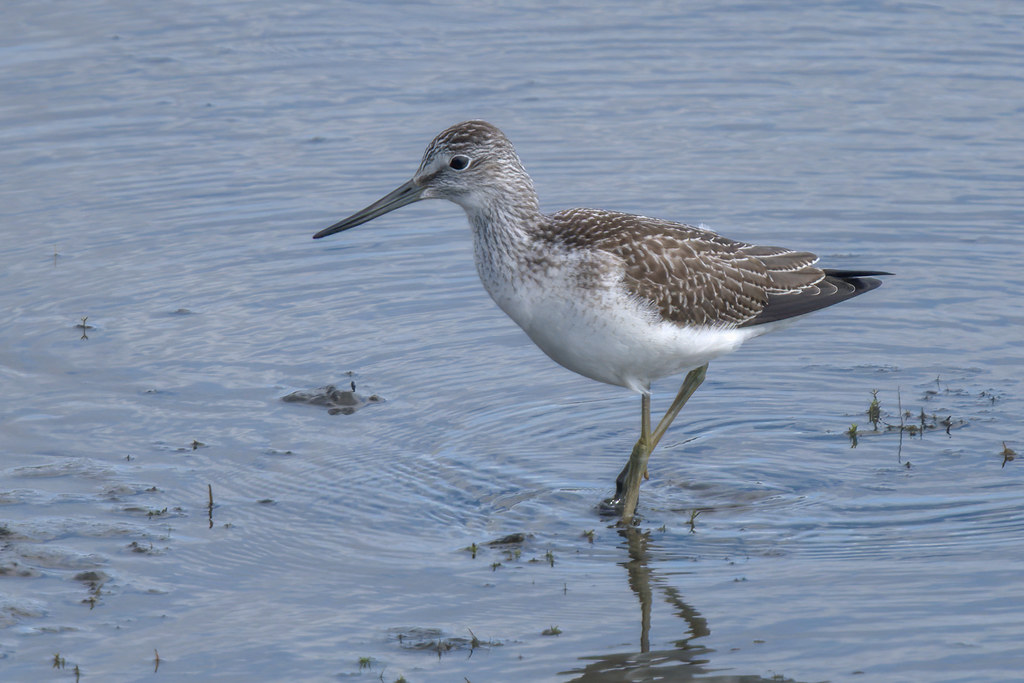
Tim writes: Greenshank is a scarce breeding bird of northern Scotland, with about 1100 pairs breeding particularly in the wet, peaty bogs of the Flow Country in the far north. But the Scottish population is a tiny fraction of the European population that breeds in the taiga zone across Scandinavia and NW Russia which is estimated at 78-132,000 pairs. Many of these overwinter in West Africa but use Britain as a staging post in spring and especially autumn, though a small number do overwinter in Britain. This was one such passage bird that I photographed in the Dearne Valley in South Yorkshire in September.
The name Redshank is very old having been used since at least 1525, but Greenshank was coined more than 200 years later, by Thomas Pennant in 1768. John Ray in 1678 (90 years earlier) simply called it the Tringa and describes its legs as “long, lead-coloured with a tincture of green”. Confusingly Tringa was the name Aldrovandus used for Green Sandpiper in 1599, which Ray refers to as the “Tringa of Aldrovandi”. Tringa nebularia is Greenshank’s scientific name and Tringa was an unidentified water bird mentioned by Aristotle that was thrush-sized with a white rump, that bobs its tail, though that sounds like Green Sandpiper to me. Nebularia was given by Linnaeus and means “of the mist”, probably because an old name for it in Norway was Skodde-foll, which means mist-foal from its misty breeding habitat and supposed whinnying cries. Interestingly it seems to have avoided any folk names in Britain.
[registration_form]
The Provincial Names of British Birds (Swainson 1885) does give ‘Green-legged Horseman’ as an alternative name – ‘from the colour and extreme length of its legs’. This name reflects the French ‘Chevalier’ (a knight) which is used for all of the Tringa species. The Greenshank is Chevalier Aboyeur where aboyeur means ‘barker’, presumably in reference to the calls made by this species.
Nebularia, is a lovely, evocative name for the species.
Many thanks for the comment and interest. I did see Green-legged Horseman but thought that it could never be a name that anyone seriously used. Francesca Greenoak’s (1979) “All the Birds of the Air” lists Green-legged Horseman, plus Green-legged Long Shank, Barker and Greater Plover. But she also says the names for Greenshank are few and decidedly “bookish” in character. And that they cannot be traced to particular geographic localities, only to various ornithological works published during the 18th and 19th centuries, and it is difficult to say which, if any were in common usage.
Eric Hardy’s (1952) Bird Lover’s Week-end Book also lists the Horseman name, but Greenshank is absent from his seemingly extensive list of Gaelic, Welsh and Manx names.
Given where they breed perhaps there is a on older gaelic name. SNH and BTO give totally different names: BTO one just looks like a translation of greenshank, but SNH ones is “Cha deach facal a lorg airson” whatever that means. But it sounds more like a genuine old gaelic name.
Some years ago, i arrived at a favoured breeding haunt to find four or five pairs with young,
hatched during the previous week or so, this being the last third of May.
However, one pair obviously having lost eggs, were preparing to re- lay, and for a while i was treated to the most superb display, the power and speed of flight were astounding, combined with the wild, ringing cries, it was un unforgettable experience.
Even better, the pair then alighted, and i was doubly fortunate to witness the hen laying the first egg of her new clutch.
A fantastic bird.